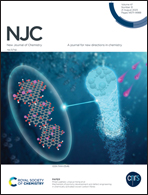Efficient binder-free electrode with a derivative synthesis of a four-leaf clover cobalt oxide from a metal organic framework on nickel foam as an energy storage device
Abstract
A Co-based metal organic framework derivative is considered to be a promising electroactive material for battery and supercapacitor hybrids (BSHs) for energy conservation, owing to the large surface area, high porosity and cobalt compound composition. Cobalt oxide generates numerous redox reactions and transfers abundant electricity during the charge/discharge process due to multiple redox states. A binder-free electrode is promising to reduce fabricating costs and avoid using non-conductive binders. In this work, a new oxidized zeolitic imidazolate framework-67 (O67) is synthesized on Ni foam without a binder at different temperatures as the electroactive material for BSHs for the first time. A unique four-leaf clover (FLC) morphology is obtained for O67, and more FLC is melted at higher oxidation temperatures. The highest specific capacitance (CF) of 221.5 F g−1 at 20 mV s−1 is obtained for the O67 electrode prepared at 350 °C (O67-350), while the unoxidized electrode only presents a CF value of 91.4 F g−1. The BSH is fabricated using an O67-350 electrode and a carbon electrode. At 500 W kg−1, a maximum energy density of 23.1 W h kg−1 is obtained. Also, the CF remains at 65% of the initial value after 5000 cycles. This study initiates new design routes to develop novel zeolitic imidazolate framework-67 derivatives on nickel foam directly as binder-free electrodes.



 Please wait while we load your content...
Please wait while we load your content...